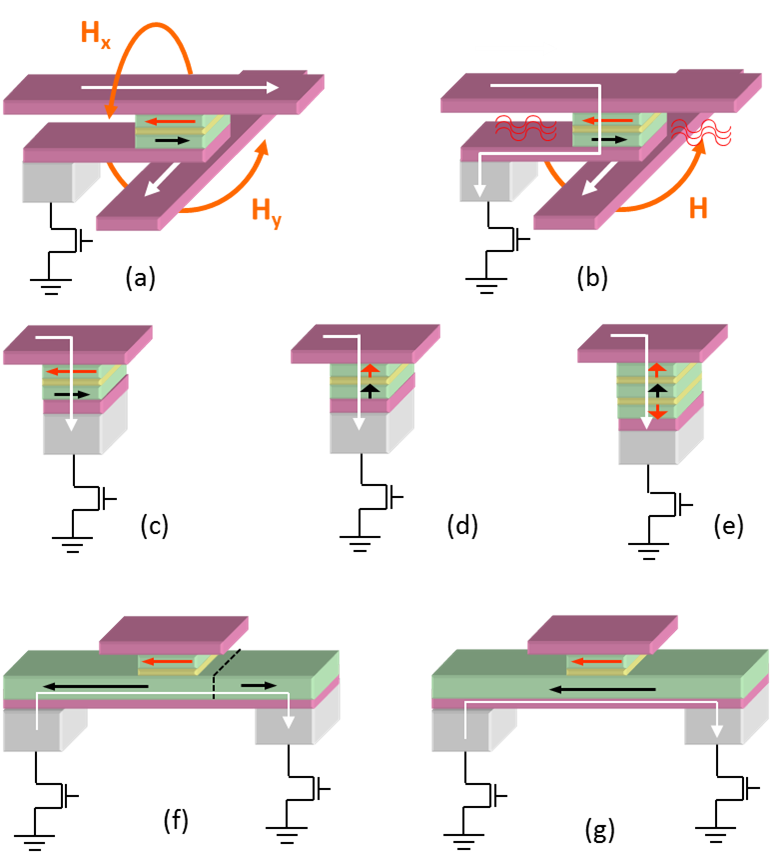Thematic overview
Magnetic Random Access Memories (MRAM) is a non-volatile memory technology, where information is stored by the magnetization direction of magnetic electrodes, very similar to computer hard-disk drives. The goal for MRAM memory is to simultaneously achieve high-speed read/write times, high density and unlimited cycling compared to other existing and emerging technologies.
Our group is developing advanced MRAM cell concepts patented at Spintec. The concepts are based on the use of temperature to reduce power consumption and increase the stability of the stored information. These ideas go beyond the conventional MRAM approach. The naturally occurring temperature increase during the write step is not lost, but is instead used to achieve the seemingly opposing goal of lowering the power consumption and increasing the thermal stability in the operating temperature range. Our group fosters young and experienced researchers developing/applying their expertise in the field of MRAM.

Questions to be addressed
Our main research axis is to use the naturally occurring temperature increase during the write step, when a current flows through the magnetic tunnel junction. The heating is used to go above a temperature threshold, making it possible to write the storage layer magnetization. This principle has been applied to in-plane magnetization cells using a storage layer pinned by an anti-ferromagnet and recently to perpendicular anisotropy cells. Our group’s goal is to demonstrate the proof-of-concept and then improve MRAM cell properties.
Our work involves the development of magnetic material systems, nano-fabrication (20-200nm cells), characterization of devices (magnetic & electrical) and simulation of the device behavior. Our activity in these vast fields is as follows;: On materials research, we are developing magnetic tunnel junctions with in-plane and perpendicular magnetic anisotropy. New electrode stacks having the material properties required by each specific concept need to be integrated in magnetic tunnel junctions, while achieving high levels of TMR signal. For the characterization of each concept we determine the write window parameters in terms of magnetic field, power consumption and magnetization reversal dynamics. Macrospin and micromagnetic simulation provide a better physical understanding of the system properties and the possibilities for optimization.
Projects
ANR EXCALYB – Perpendicular Anisotropy Materials for High-Density Non-volatile Magnetic Memory Cells
Crocus R&D – Thermally assisted MRAM
Samsung SGMI
Partners
Crocus Technology
Institut Néel
SP2M/NM
SAMSUNG
Applied Materials
SINGULUS
Recent news
- Post-doctoral position – Spintronic Spiking Neurons [December 07th, 2020]
In the frame of the French national ANR project SpinSpike, Spintec laboratory is opening a postdoctoral researcher position. The candidate will work in collaboration with UMPhy CNRS-Thales and Thales TRT. The objective is the realization ... - PhD defense – Memristive magnetic memory for spintronic synapses [December 07th, 2020]
On Thursday, December 17, 2020 at 13H30, Marco Mansueto will defend his PhD entitled: Memristive magnetic memory for spintronic synapses Video conference: https://grenoble-inp.zoom.us/j/96102161721 Abstract : In the context ... - Pushing the limits of fast swept-tuned spectrum analysis using Spin-Torque Nano-Oscillators [November 16th, 2020]
Recent progress in nanotechnology has led to the development of spin-torque nano-oscillators (STNO), whose time constants, due to their nano-scale size, are naturally of the order of 1-100 nanoseconds. At SPINTEC we demonstrated experimentally for ... - Unveiling the heart of magnetic memory cells thanks to electron holography [November 10th, 2020]
Magnetic spintronic memory called STT-MRAM have recently entered in volume production at major microelectronic foundries. The research in this area is now focused on preparing the future memory generations with higher capacity, higher speed, lower ... - MAGALIGN – ERC Proof of Concept grant [October 28th, 2020]
ERC Proof of Concept grant MAGALIGN is awarded in the framework of ERC Project MAGICAL The launching of a new generation of spintronic memory (STT-MRAM) in volume production in 2019 by all major microelectronics companies marks ...

SOUSA Ricardo
ricardo.sousa@cea.fr

BALTZ Vincent
vincent.baltz@cea.fr

PREJBEANU Lucian
lucian.prejbeanu@cea.fr

DIENY Bernard
bernard.dieny@cea.fr





